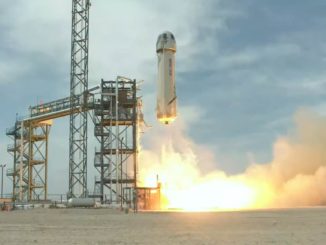STORY WRITTEN FOR CBS NEWS & USED WITH PERMISSION
SpaceX launched its sub-scale Starship “hopper” spacecraft on a brief unpiloted up-and-down test flight at the company’s Boca Chica, Texas, test facility Tuesday, a dramatic demonstration of rocket technology intended to pave the way to a new, more powerful heavy lift booster and, eventually, crew-carrying interplanetary spacecraft.
Running a day late because of a last-second technical glitch, the squat Starhopper’s powerful methane-fueled Raptor engine thundered to life at 6:02 p.m. EDT, pushing the stubby test vehicle straight up into a clear blue sky atop a jet of flame and a churning cloud of exhaust.
The spacecraft, shaped a bit like R2-D2 from the “Star Wars” movies, appeared to reach its FAA-approved 492-foot (150 meter) altitude limit, moved sideways and slowly descended to touchdown on a nearby landing pad. The approximately one-minute flight was the rocket’s second “untethered” test following a July jump to an altitude of about 65 feet.
The hardware SpaceX is testing is intended for a fully reusable two-stage vehicle featuring a powerful first stage, dubbed the Super Heavy Rocket, and the winged Starship.
The hopper is a sub-scale version of the Starship’s propulsion system, the first to utilize a SpaceX-designed Raptor engine burning cryogenic methane with liquid oxygen.
SpaceX says the new booster-Starship system eventually will replace the company’s Falcon 9 and Falcon Heavy rockets as well as the Cargo and Crew Dragon capsules used to deliver supplies and, eventually, astronauts to the International Space Station.
“SpaceX’s Starship and Super Heavy Rocket are designed to deliver satellites to Earth orbit and beyond, at a lower marginal cost per launch than our current Falcon vehicles,” the company says on its web site.
With a 30-foot-wide payload compartment, the Starship will be able to launch larger payloads to Earth orbit than current rocket systems and deliver crews and supplies to the space station, the company says, adding that in the long term, Starship also will be able to deliver crews and cargo to the moon and, eventually, Mars.
SpaceX founder Elon Musk has said the company’s “aspirational goal” is to launch an initial cargo mission to Mars in 2022, followed by a crewed flight as early as 2024. Musk is expected to deliver an update on the rocket’s development soon and those targets could change.



